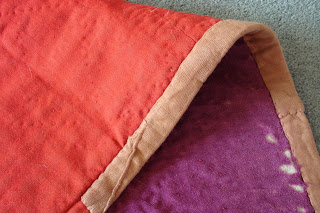

The last room of the V & A exhibition was probably of the most interest to me; there was a good Sanderson Star quilt on display, draped over a quilting frame. I have always been impressed by this striking pattern and have four star quilts. One purpose of this blog was to spur me on to "do" something with the quilts. My idea with the star quilts was to compare the measurements and use some simple statistics to discover whether there was a common formula to this quilt. The pattern seems to often have been bought ready made and marked, as a quilt top - an early form of the "kit" format. The borders could be expected to vary a lot but was the centre star made to a common pattern and size? and were the quilting patterns also stitched according to a set style? I only have four quilts so in scientific terms a very small sample size - but of course one could measure other quilts and enlarge the database. The attraction is that this numerical evaluation is very similar to the scientific research that I did (and many, many student environmental/ecological research projects that I had to supervise and then mark).
Many of my quilts were inexpensive buys and what I term "study items". Indeed, they might be termed UGLY quilts. They are ertainly not beautiful designer items, but all have been bought for a reason. I mentioned earlier that the everyday quilts were used to destruction and not many survive in some cases. What was found on most people's beds? These star quilts seem to have been considered special - but as a utilitarian item many were still used hard. Viz the fact that of my four quilts, one is unused, one is very faded and rebound, one is worn and stained and the final one is very whiskered. All are north country quilts but again one from Durham, one from Northumberland, one from "Tyne and Wear" and the final one from Cleveland - so a bit of a geographical spread. I will try to do the measurements this weekend and then analyse the results and share them with you. As in an experiment, one can either prove or disprove the question - "are the quilts similar?" Even a "No" answer would be of interest. Or, perhaps it will be "yes, but..." That's the fun!
Here is the first quilt -it measures 80" x 93" and it is an unusual colour combination in cotton sateen of bronze and a lurid mint green. The colours do not show up well in the photos. The reverse is the bronze sateen. Cotton sateen was not maunfactured after 1936 so the colours and fabric suggest a 1930's date?? Any suggestions??
The quilt came from an auction in North Yorkshire but was one of five quilts from a house clearance in Barnard Castle in County Durham. Three of the quilts were used - this was one of two unused quilts. This is a "stamped" quilt and the blue pencil markings are still intact as the quilt has never been washed and appears unused.
The quilting patterns are:
Centre - rose in a ring plus small fern
Diamonds - rose plus feather or fern
Squares - diamond infill plus large rose
Border 1 - unknown fleur de lys scroll Border 2 - floral scroll Border 3 - Small twist Border 4 - large floral Scroll Border 5 Twist with central diamond
All the borders are "turned" with a different corner motif.
The quilting thread looks like sewing thread in a light brown colour. The quilting stitches are 8 to the inch, and not especially even, so perhaps not made by an experienced quilter. The wadding is thin cotton. Edges are machine sewn. The star and borders have been machine pieced.
I will be showing the other three quilts over subsequent posts.























